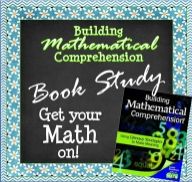Happy 4th of July! Today I am linking up with Cara from
The First Grade Parade, one of the very first blogs I started following when I returned to the first grade classroom, for her Throwback Thursday linky. I've only been blogging about a year so I don't have a lot of old posts, but this is one of my favorites. I'm drawn to it because it represents a big moment in my math teaching last year. This anchor chart became one of the most used and powerful tools in my classroom. I would still see students studying it while solving problems in May, looking for another way they could show their work and solve the problem.
Here's the post from October, 2012:
My district provides
Exemplars for math problem solving, and my school has made using them a priority this year. I am the first grade representative on our campus math committee, so I will be partially responsible for guiding my team through the implementation of Exemplars. Fortunately, I was already familiar with the program from my time in another district, but I have never used them with a whole class before. So I decided this week to try out some Exemplar-type work with my class so I could share with my team before we actually do our first real Exemplar problem for our portfolios.
On Wednesday, our daily journal prompt was:
I have 8 apples. Some are green and some are red. How many of each can I have?
Many children just wrote the equation 4+4=8 and then drew a picture. There wasn't a lot of evidence of their thinking although I was pleased that several of the students were able to verbalize that since 8 was an even number they knew they could make 2 equal groups! So on Thursday I decided to change things up just a little and incorporate some of the routines that our math committee has established for Exemplars. I wanted to emphasize that:
1. Mathematicians show their work in different ways.
2. You need to circle your answer.
3. Use math vocabulary to explain your thinking and then highlight those words (an Exemplar strategy).
We started by discussing Wednesday's problem, and then I started a chart of ways mathematicians show their work. I saw a similar chart on Donna's blog,
The Math Coach's Corner. (I learn so much every time I visit her blog!) Here is the chart we created- minus "table" as we added it later.
Then I posed this problem:
After we read the problem together, I had the students tell me what they were trying to find. I made sure that the word combinations was mentioned. We discussed possible strategies, and then I let them go to work, reminding them to circle their answer and tell how they found the answer. I gave each student a sheet of manila paper to work on. Some students immediately started to write equations. Others started to draw baskets. Interestingly, a couple of students started to draw 8 boxes on their paper. When I asked why, they weren't sure. I think it is because we use this paper often for what I call 8-square activities; for example, I will write 8 short a words and the students will copy one in each box and draw a picture. I noticed also that some students were spending most of their time drawing and coloring baskets so I stopped the class and did a quick reteach on math drawings and reminded them that these were quick sketches, not art class drawings!
When I noticed that most students seemed to finished or close to finishing we stopped and discussed some of the strategies they used and shared how many combinations they found. About half the class found that there were 6 combinations. We then used our highlighters to show any math words we used in our explanations. Most students had one math word such as "I wrote
number sentences" or "I used
counters." I then explained that mathematicians like to make sure of their answers by showing their work in a different ways and use more math language to explain what they have done.
The next day I used this same problem to introduce a new way to show work. I used one student's work to show how she had the same combination twice, and I talked about how many students kept asking me if they were finished because they didn't know if they had found all of the ways. I told them that sometimes we need a way to organize our data. Using seven 2 color counters, I showed them how I would start with one red and then count how many were yellow. I wrote this information on the Smart board in table form. Then we made 2 red, counted the yellow and wrote it on the table. Then I just wrote a 3 in the red column and asked "How many yellow?" We completed the table together, checking with our counters, and I explained that a table was one way to organize your thinking when working with combinations. Then we added it to our chart.
This week we will do a similar problem: "
There are 8 animals in the barn. Some are cows and some are horses. How many different combinations of animals could be in the barn." I can't wait to see how they approach the problem now!
Enjoy your Independence Day festivities!











































